A Long-Term Study on the Bactericidal Effect of ZrN-Cu Nanostructured Coatings Deposited by an Industrial Physical Vapor Deposition System
Abstract
1. Introduction
2. Materials and Methods
2.1. Synthesis
2.2. Characterization
2.3. Evaluation of Long-Term Bactericidal Properties
- Obtaining the bacterial samples using a sterile cotton swab saturated with phosphate-buffered saline (PBS) along the whole length of the door handles (210 mm) twice. One side of the swab wiped the upper part of the handle, and the other side wiped the bottom part of the handle.
- Putting the swab into a tube with 1 mL PBS.
- Vortexing the tube with the swab thoroughly for 60 s.
- Pipetting 100 µL of the solution after thorough vortexing on Tryptone Soya Agar (TSA) plates in triplicate (so 300 µL in total on 3 TSA plates).
- Spreading the solution evenly across the whole plate using a spreader.
- Incubating the TSA plates at 30 °C for 48 h.
- Enumeration of the colony-forming units (CFU) grown.
2.4. Cu Release Measurement
3. Results and Discussion
3.1. Chemical Composition and Crystalline Structure
3.2. Long-Term Bactericidal Properties
3.2.1. Coupons
3.2.2. Cylindrical Samples
3.3. Post-Exposure Analyses
3.3.1. Roughness
3.3.2. Microstructure
3.3.3. Cu Release Rate
4. Conclusions
Supplementary Materials
Author Contributions
Funding
Data Availability Statement
Conflicts of Interest
References
- Mohammady, M.; Radmeh, M.; Taherian, H.; Tahmourespour, A.; Hashemi, S.T. Effect of Copper-Coated Surfaces on the Bacterial Burden in the Intensive Care Unit. Iran. Red Crescent Med. J. 2021, 24, e1433. [Google Scholar] [CrossRef]
- Hinsa-Leasure, S.M.; Nartey, Q.; Vaverka, J.; Schmidt, M.G. Copper Alloy Surfaces Sustain Terminal Cleaning Levels in a Rural Hospital. Am. J. Infect. Control 2016, 44, e195–e203. [Google Scholar] [CrossRef] [PubMed]
- Bisht, N.; Dwivedi, N.; Kumar, P.; Venkatesh, M.; Yadav, A.K.; Mishra, D.; Solanki, P.; Verma, N.K.; Lakshminarayanan, R.; Ramakrishna, S.; et al. Recent Advances in Copper and Copper-Derived Materials for Antimicrobial Resistance and Infection Control. Curr. Opin. Biomed. Eng. 2022, 24, 100408. [Google Scholar] [CrossRef] [PubMed]
- Of, S.; In, H.; Eu, T.H.E. Health at a Glance: Europe 2018 (Summary in Spanish); 2018; ISBN 9789264303348. Available online: https://www.oecd-ilibrary.org/social-issues-migration-health/health-at-a-glance-europe-2018_health_glance_eur-2018-en (accessed on 30 December 2022).
- Abraham, J.; Dowling, K.; Florentine, S. Can Copper Products and Surfaces Reduce the Spread of Infectious Microorganisms and Hospital-Acquired Infections? Materials 2021, 14, 3444. [Google Scholar] [CrossRef] [PubMed]
- Potter, B.A.; Lob, M.; Mercaldo, R.; Hetzler, A.; Kaistha, V.; Khan, H.; Kingston, N.; Knoll, M.; Maloy-Franklin, B.; Melvin, K.; et al. A Long-Term Study Examining the Antibacterial Effectiveness of Agion Silver Zeolite Technology on Door Handles within a College Campus. Lett. Appl. Microbiol. 2015, 60, 120–127. [Google Scholar] [CrossRef]
- Aboubakr, H.A.; Sharafeldin, T.A.; Goyal, S.M. Stability of SARS-CoV-2 and Other Coronaviruses in the Environment and on Common Touch Surfaces and the Influence of Climatic Conditions: A Review. Transbound. Emerg. Dis. 2021, 68, 296–312. [Google Scholar] [CrossRef]
- Bueckert, M.; Gupta, R.; Gupta, A.; Garg, M.; Mazumder, A. Correction: Bueckert et al. Infectivity of SARS-CoV-2 and Other Coronaviruses on Dry Surfaces: Potential for Indirect Transmission. Materials 2020, 13, 5211. Materials 2021, 14, 2816. [Google Scholar] [CrossRef] [PubMed]
- Glass, A.; Klinkhammer, K.E.; Christofferson, R.C.; Mores, C.N. Efficacy of Copper Blend Coatings in Reducing SARS-CoV-2 Contamination. BioMetals 2022, 36, 217–225. [Google Scholar] [CrossRef]
- Bäumler, W.; Eckl, D.; Holzmann, T.; Schneider-Brachert, W. Antimicrobial Coatings for Environmental Surfaces in Hospitals: A Potential New Pillar for Prevention Strategies in Hygiene. Crit. Rev. Microbiol. 2022, 48, 531–564. [Google Scholar] [CrossRef]
- Nakhaie, D.; Williams, T.C.; Velapatino, B.; Bryce, E.A.; Charles, M.K.; Asselin, E.; Clifford, A.M. An Engineered Nanocomposite Copper Coating with Enhanced Antibacterial Efficacy. Adv. Mater. Interfaces 2022, 9, 2201009. [Google Scholar] [CrossRef]
- Feng, J.; Tong, S.Y.; Thian, E.S.; Yang, C.; Yang, K.; Gong, N.; Misra, K.P.; Misra, R.D.K. Nanostructuring of Biomaterials and Reducing Implant Related Infections via Incorporation of Silver and Copper as Antimicrobial Elements: An Overview. Mater. Technol. 2022, 37, 867–879. [Google Scholar] [CrossRef]
- Meister, T.L.; Fortmann, J.; Breisch, M.; Sengstock, C.; Steinmann, E.; Köller, M.; Pfaender, S.; Ludwig, A. Nanoscale Copper and Silver Thin Film Systems Display Differences in Antiviral and Antibacterial Properties. Sci. Rep. 2022, 12, 7193. [Google Scholar] [CrossRef]
- Slavin, Y.N.; Asnis, J.; Häfeli, U.O.; Bach, H. Metal Nanoparticles: Understanding the Mechanisms behind Antibacterial Activity. J. Nanobiotechnol. 2017, 15, 65. [Google Scholar] [CrossRef]
- Musil, J.; Zítek, M.; Fajfrlík, K.; Čerstvý, R. Flexible Antibacterial Zr-Cu-N Thin Films Resistant to Cracking. J. Vac. Sci. Technol. A Vac. Surf. Films 2016, 34, 021508. [Google Scholar] [CrossRef]
- Stranak, V.; Wulff, H.; Rebl, H.; Zietz, C.; Arndt, K.; Bogdanowicz, R.; Nebe, B.; Bader, R.; Podbielski, A.; Hubicka, Z.; et al. Deposition of Thin Titanium-Copper Films with Antimicrobial Effect by Advanced Magnetron Sputtering Methods. Mater. Sci. Eng. C 2011, 31, 1512–1519. [Google Scholar] [CrossRef]
- Hadrup, N.; Sharma, A.K.; Loeschner, K. Toxicity of Silver Ions, Metallic Silver, and Silver Nanoparticle Materials after in Vivo Dermal and Mucosal Surface Exposure: A Review. Regul. Toxicol. Pharmacol. 2018, 98, 257–267. [Google Scholar] [CrossRef] [PubMed]
- Knobloch, J.K.M.; Tofern, S.; Kunz, W.; Schütze, S.; Riecke, M.; Solbach, W.; Wuske, T. “Life-like” Assessment of Antimicrobial Surfaces by a New Touch Transfer Assay Displays Strong Superiority of a Copper Alloy Compared to Silver Containing Surfaces. PLoS ONE 2017, 12, e0187442. [Google Scholar] [CrossRef] [PubMed]
- Kumar, D.D.; Kaliaraj, G.S. Multifunctional Zirconium Nitride/Copper Multilayer Coatings on Medical Grade 316L SS and Titanium Substrates for Biomedical Applications. J. Mech. Behav. Biomed. Mater. 2018, 77, 106–115. [Google Scholar] [CrossRef] [PubMed]
- Purniawan, A.; Lusida, M.I.; Pujiyanto, R.W.; Nastri, A.M.; Permanasari, A.A.; Harsono, A.A.H.; Oktavia, N.H.; Wicaksono, S.T.; Dewantari, J.R.; Prasetya, R.R.; et al. Synthesis and Assessment of Copper-Based Nanoparticles as a Surface Coating Agent for Antiviral Properties against SARS-CoV-2. Sci. Rep. 2022, 12, 4835. [Google Scholar] [CrossRef] [PubMed]
- Weaver, L.; Michels, H.T.; Keevil, C.W. Potential for Preventing Spread of Fungi in Air-Conditioning Systems Constructed Using Copper Instead of Aluminium. Lett. Appl. Microbiol. 2010, 50, 18–23. [Google Scholar] [CrossRef]
- Warnes, S.L.; Summersgill, E.N.; Keevil, C.W. Inactivation of Murine Norovirus on a Range of Copper Alloy Surfaces Is Accompanied by Loss of Capsid Integrity. Appl. Environ. Microbiol. 2015, 81, 1085–1091. [Google Scholar] [CrossRef] [PubMed]
- Warnes, S.L.; Keevil, C.W. Inactivation of Norovirus on Dry Copper Alloy Surfaces. PLoS ONE 2013, 8, e75017. [Google Scholar] [CrossRef]
- Govind, V.; Bharadwaj, S.; Sai Ganesh, M.R.; Vishnu, J.; Shankar, K.V.; Shankar, B.; Rajesh, R. Antiviral Properties of Copper and Its Alloys to Inactivate Covid-19 Virus: A Review. BioMetals 2021, 34, 1217–1235. [Google Scholar] [CrossRef] [PubMed]
- Luo, J.; Hein, C.; Mücklich, F.; Solioz, M. Killing of Bacteria by Copper, Cadmium, and Silver Surfaces Reveals Relevant Physicochemical Parameters. Biointerphases 2017, 12, 020301. [Google Scholar] [CrossRef]
- Vincent, M.; Duval, R.E.; Hartemann, P.; Engels-Deutsch, M. Contact Killing and Antimicrobial Properties of Copper. J. Appl. Microbiol. 2018, 124, 1032–1046. [Google Scholar] [CrossRef] [PubMed]
- Mahmoudi, P.; Akbarpour, M.R.; Lakeh, H.B.; Jing, F.; Hadidi, M.R.; Akhavan, B. Antibacterial Ti–Cu Implants: A Critical Review on Mechanisms of Action. Mater. Today Bio 2022, 17, 100447. [Google Scholar] [CrossRef] [PubMed]
- Michels, H.T.; Keevil, C.W.; Salgado, C.D.; Schmidt, M.G. From Laboratory Research to a Clinical Trial: Copper Alloy Surfaces Kill Bacteria and Reduce Hospital-Acquired Infections. Health Environ. Res. Des. J. 2015, 9, 64–79. [Google Scholar] [CrossRef]
- Bryce, E.A.; Velapatino, B.; Donnelly-Pierce, T.; Wong, T.; Dixon, R.; Akbari Khorami, H.; Asselin, E. Evaluating the Antimicrobial Activity of Copper Surfaces against Pseudomonas Aeruginosa and Staphylococcus Aureus 1 Year after Use in a Microbiology Laboratory. J. Hosp. Infect. 2022, 123, 186–188. [Google Scholar] [CrossRef]
- Casey, A.L.; Adams, D.; Karpanen, T.J.; Lambert, P.A.; Cookson, B.D.; Nightingale, P.; Miruszenko, L.; Shillam, R.; Christian, P.; Elliott, T.S.J. Role of Copper in Reducing Hospital Environment Contamination. J. Hosp. Infect. 2010, 74, 72–77. [Google Scholar] [CrossRef]
- Mikolay, A.; Huggett, S.; Tikana, L.; Grass, G.; Braun, J.; Nies, D.H. Survival of Bacteria on Metallic Copper Surfaces in a Hospital Trial. Appl. Microbiol. Biotechnol. 2010, 87, 1875–1879. [Google Scholar] [CrossRef]
- Ji, M.K.; Park, S.W.; Lee, K.; Kang, I.C.; Yun, K.D.; Kim, H.S.; Lim, H.P. Evaluation of Antibacterial Activity and Osteoblast-like Cell Viability of TiN, ZrN and (Ti1-XZrx)N Coating on Titanium. J. Adv. Prosthodont. 2015, 7, 166–171. [Google Scholar] [CrossRef]
- Brunello, G.; Brun, P.; Gardin, C.; Ferroni, L.; Bressan, E.; Meneghello, R.; Zavan, B.; Sivolella, S. Biocompatibility and Antibacterial Properties of Zirconium Nitride Coating on Titanium Abutments: An in Vitro Study. PLoS ONE 2018, 13, e0199591. [Google Scholar] [CrossRef]
- Ramoul, C.; Beliardouh, N.E.; Bahi, R.; Nouveau, C.; Djahoudi, A.; Walock, M.J. Surface Performances of PVD ZrN Coatings in Biological Environments. Tribol.—Mater. Surf. Interfaces 2019, 13, 12–19. [Google Scholar] [CrossRef]
- Tian, X.B.; Wang, Z.M.; Yang, S.Q.; Luo, Z.J.; Fu, R.K.Y.; Chu, P.K. Antibacterial Copper-Containing Titanium Nitride Films Produced by Dual Magnetron Sputtering. Surf. Coat. Technol. 2007, 201, 8606–8609. [Google Scholar] [CrossRef]
- Sharifahmadian, O.; Salimijazi, H.R.; Fathi, M.H.; Mostaghimi, J.; Pershin, L. Relationship between Surface Properties and Antibacterial Behavior of Wire Arc Spray Copper Coatings. Surf. Coat. Technol. 2013, 233, 74–79. [Google Scholar] [CrossRef]
- Behrangi, S.; Sedláček, I.; Štěrba, J.; Suková, G.; Czigány, Z.; Buršíková, V.; Souček, P.; Sochora, V.; Balázsi, K.; Vašina, P. An Assessment of the Bactericidal and Virucidal Properties of ZrN-Cu Nanostructured Coatings Deposited by an Industrial PVD System. Coatings 2022, 12, 1330. [Google Scholar] [CrossRef]
- ISO 22196; Measurement of Antibacterial Activity on Plastics and Other Non-Porous Surfaces. ISO: Geneva, Switzerland, 2011; pp. 1–24.
- Cullity, B.D.; Stock, S.R. Elements of X-Ray Diffraction: Pearson New International, 3rd ed.; Pearson: London, UK, 2013; p. 656. [Google Scholar]
- Oliver, W.C.; Pharr, G.M. An Improved Technique for Determining Hardness and Elastic Modulus Using Load and Displacement Sensing Indentation Experiments. J. Mater. Res. 1992, 7, 1564–1583. [Google Scholar] [CrossRef]
- Ciacotich, N.; Din, R.U.; Sloth, J.J.; Møller, P.; Gram, L. An Electroplated Copper–Silver Alloy as Antibacterial Coating on Stainless Steel. Surf. Coat. Technol. 2018, 345, 96–104. [Google Scholar] [CrossRef]
- Slater, J.C. Atomic Radii in Crystals. J. Chem. Phys. 1964, 41, 3199–3204. [Google Scholar] [CrossRef]
- Li, X.; Cong, Y.; Ovais, M.; Cardoso, M.B.; Hameed, S.; Chen, R.; Chen, M.; Wang, L. Copper-Based Nanoparticles against Microbial Infections. Wiley Interdiscip. Rev. Nanomed. Nanobiotechnol. 2023, 15, e1888. [Google Scholar] [CrossRef] [PubMed]
- Seo, B.; Kanematsu, H.; Nakamoto, M.; Miyabayashi, Y.; Tanaka, T. Copper Surface Treatment Method with Antibacterial Performance Using “Super-Spread Wetting” Properties. Materials 2022, 15, 392. [Google Scholar] [CrossRef]
- Robine, E.; Boulangé-Petermann, L.; Derangère, D. Assessing Bactericidal Properties of Materials: The Case of Metallic Surfaces in Contact with Air. J. Microbiol. Methods 2002, 49, 225–234. [Google Scholar] [CrossRef]
- Dan, Z.G.; Ni, H.W.; Xu, B.F.; Xiong, J.; Xiong, P.Y. Microstructure and Antibacterial Properties of AISI 420 Stainless Steel Implanted by Copper Ions. Thin Solid Films 2005, 492, 93–100. [Google Scholar] [CrossRef]
- Ishantha Senevirathne, S.W.M.A.; Hasan, J.; Mathew, A.; Jaggessar, A.; Yarlagadda, P.K.D.V. Trends in Bactericidal Nanostructured Surfaces: An Analytical Perspective. ACS Appl. Bio Mater. 2021, 4, 7626–7642. [Google Scholar] [CrossRef]
- Hutasoit, N.; Topa, S.H.; Javed, M.A.; Rahman Rashid, R.A.; Palombo, E.; Palanisamy, S. Antibacterial Efficacy of Cold-Sprayed Copper Coatings against Gram-Positive Staphylococcus Aureus and Gram-Negative Escherichia coli. Materials 2021, 14, 6744. [Google Scholar] [CrossRef]
- Razavipour, M.; Gonzalez, M.; Singh, N.; Cimenci, C.E.; Chu, N.; Alarcon, E.I.; Villafuerte, J.; Jodoin, B. Biofilm Inhibition and Antiviral Response of Cold Sprayed and Shot Peened Copper Surfaces: Effect of Surface Morphology and Microstructure. J. Therm. Spray Technol. 2022, 31, 130–144. [Google Scholar] [CrossRef]
- Gilewicz, A.; Jedrzejewski, R.; Myslinski, P.; Warcholinski, B. Structure, Morphology, and Mechanical Properties of AlCrN Coatings Deposited by Cathodic Arc Evaporation. J. Mater. Eng. Perform. 2019, 28, 1522–1531. [Google Scholar] [CrossRef]
- Ren, L.; Ma, Z.; Li, M.; Zhang, Y.; Liu, W.; Liao, Z.; Yang, K. Antibacterial Properties of Ti-6Al-4V-XCu Alloys. J. Mater. Sci. Technol. 2014, 30, 699–705. [Google Scholar] [CrossRef]
- Liu, J.; Zhang, X.; Wang, H.; Li, F.; Li, M.; Yang, K.; Zhang, E. The Antibacterial Properties and Biocompatibility of a Ti-Cu Sintered Alloy for Biomedical Application. Biomed. Mater. 2014, 9, 025013. [Google Scholar] [CrossRef] [PubMed]
- Unosson, E.; Rodriguez, D.; Welch, K.; Engqvist, H. Reactive Combinatorial Synthesis and Characterization of a Gradient Ag-Ti Oxide Thin Film with Antibacterial Properties. Acta Biomater. 2015, 11, 503–510. [Google Scholar] [CrossRef] [PubMed]
- Wang, S.; Zhu, W.; Yu, P.; Wang, X.; He, T.; Tan, G.; Ning, C. Antibacterial Nanostructured Copper Coatings Deposited on Tantalum by Magnetron Sputtering. Mater. Technol. 2015, 30, B120–B125. [Google Scholar] [CrossRef]
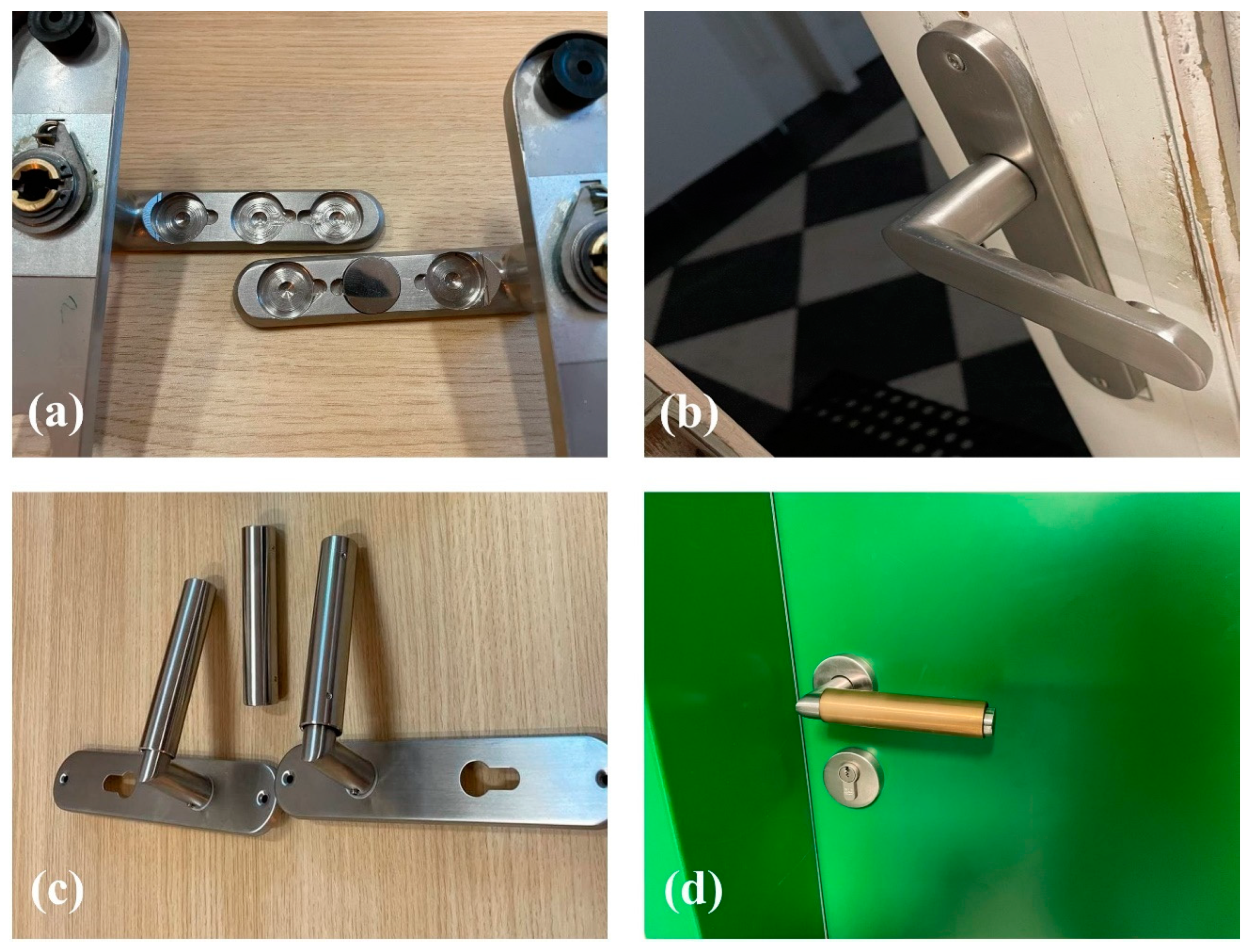


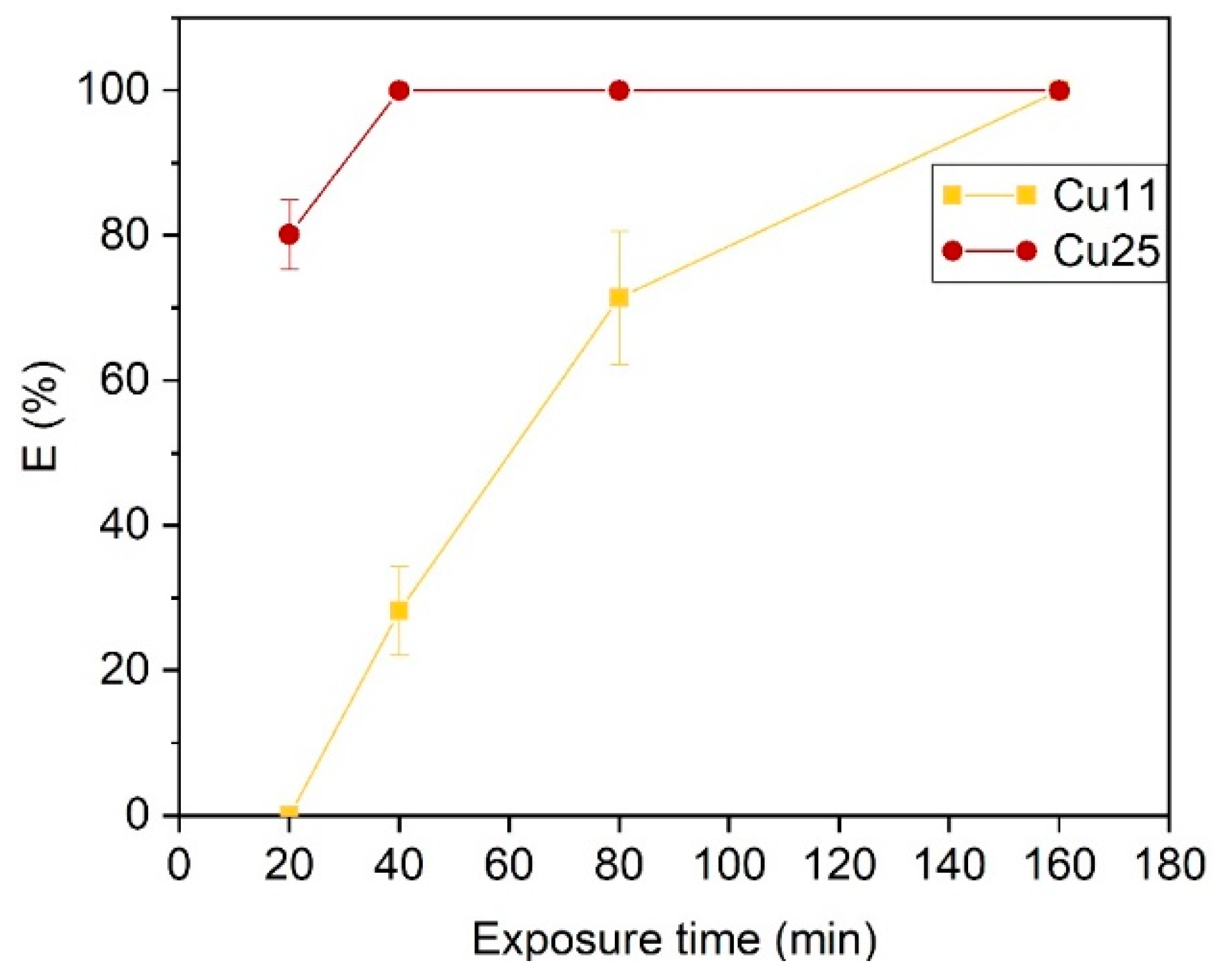
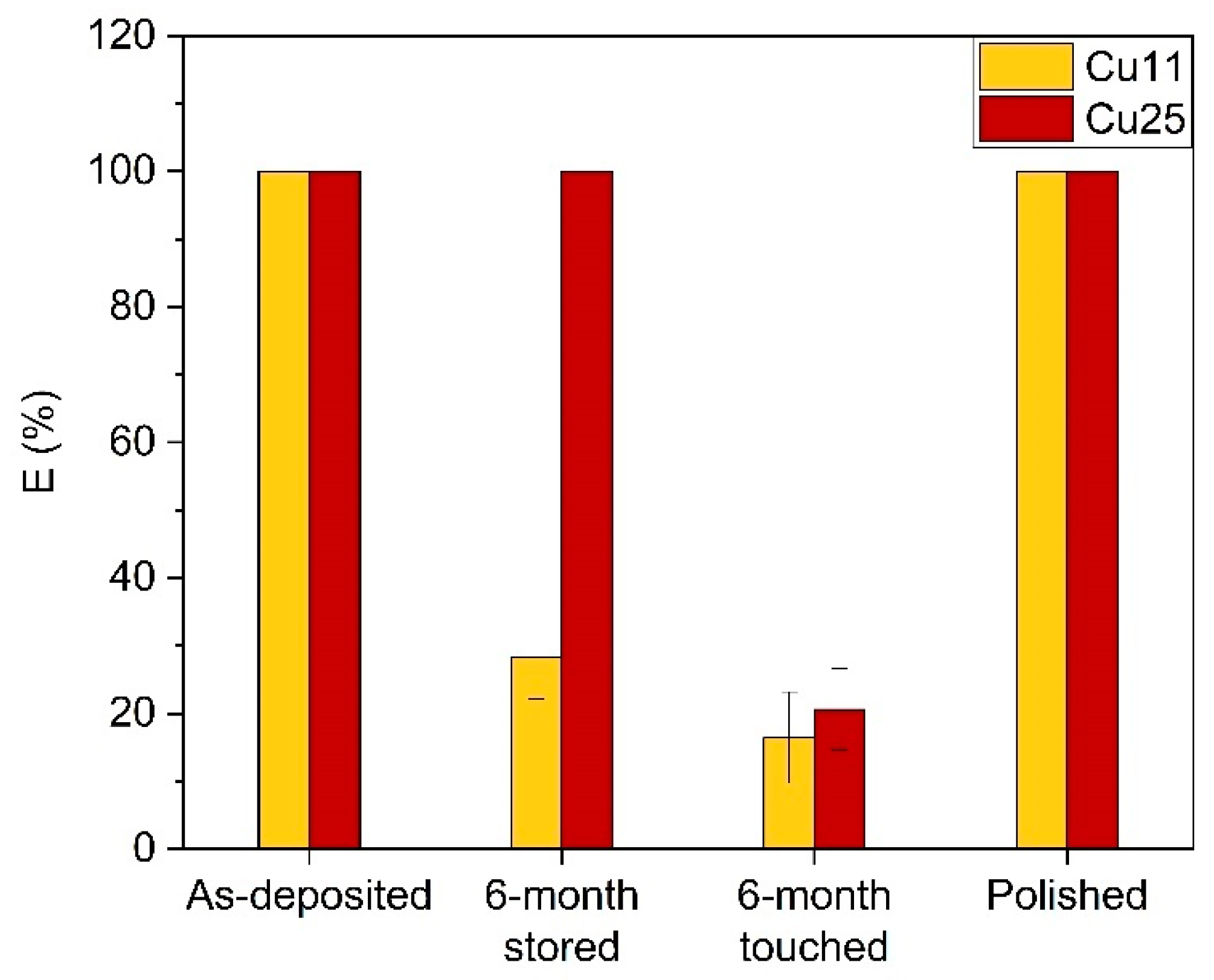
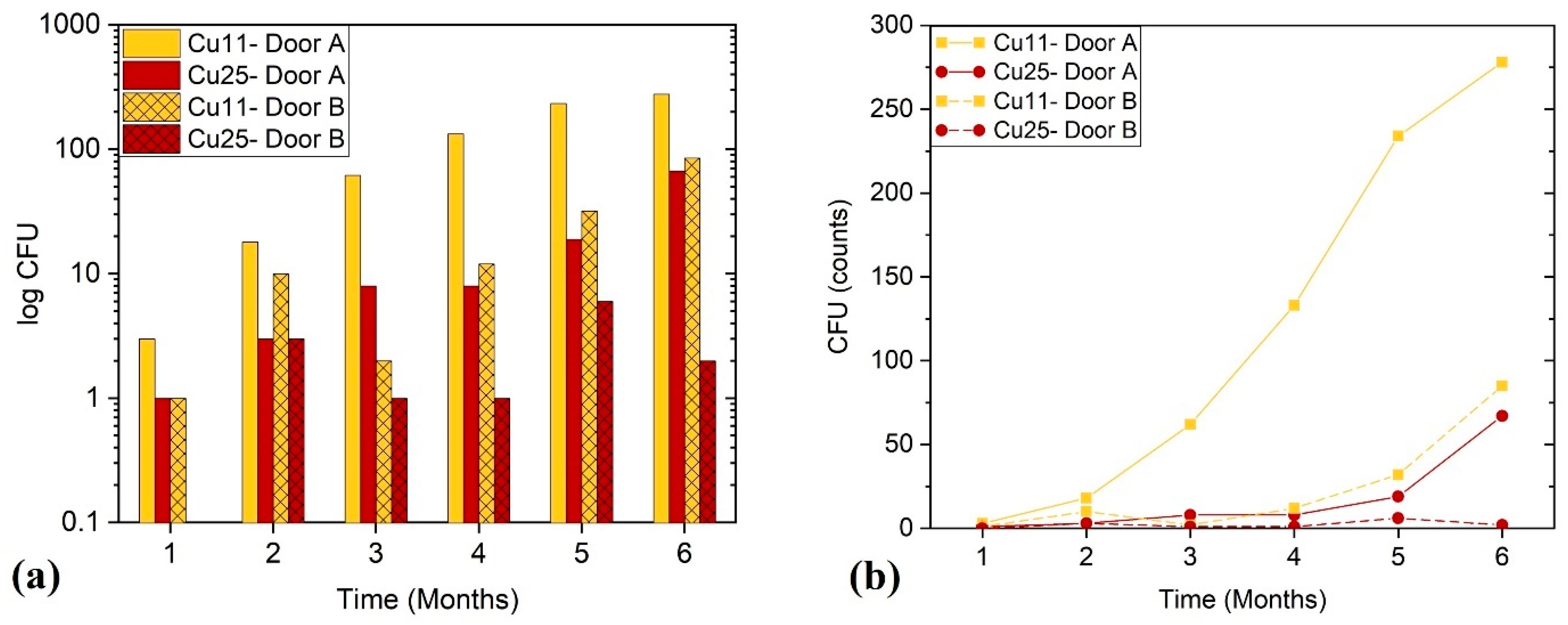
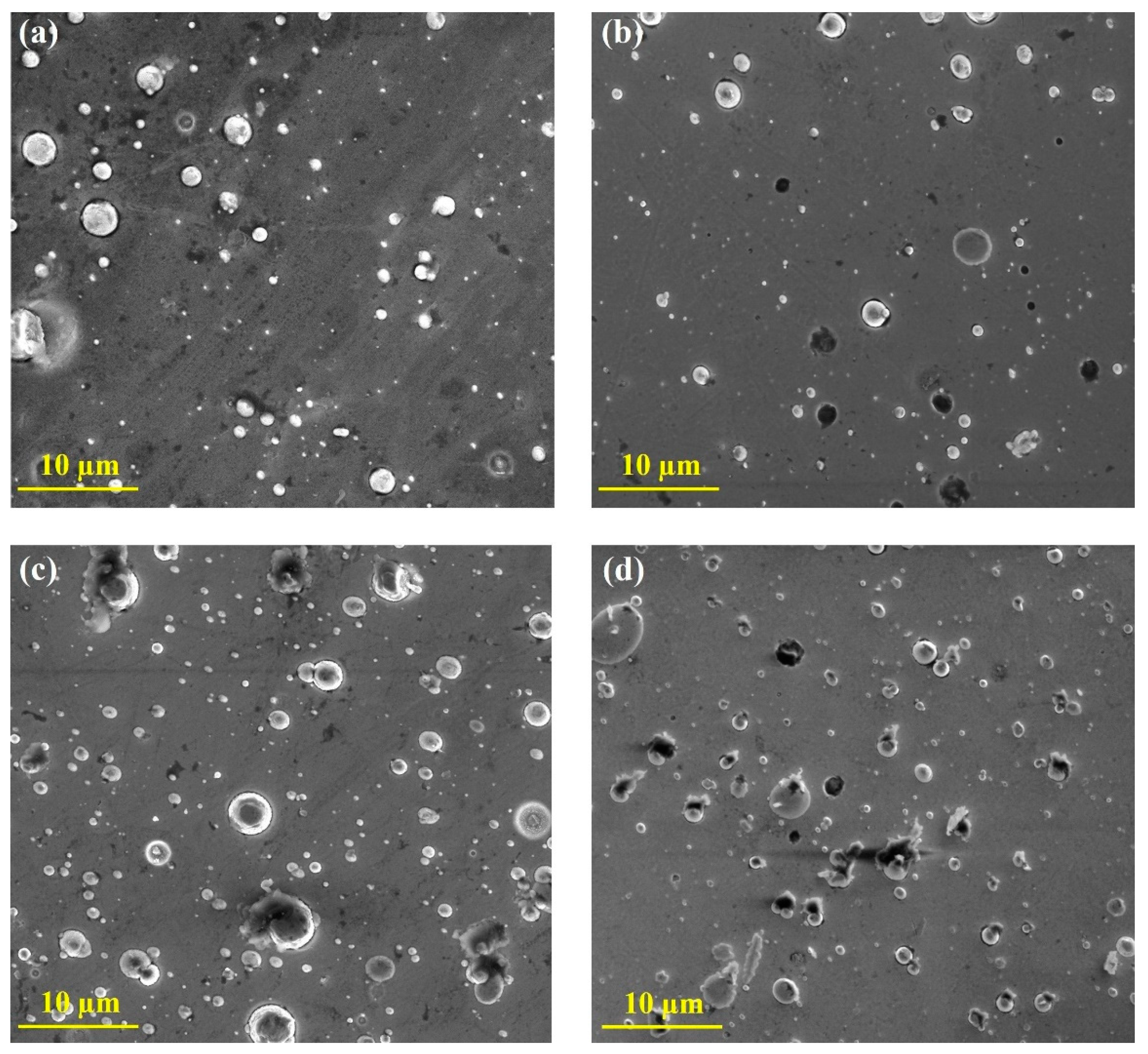
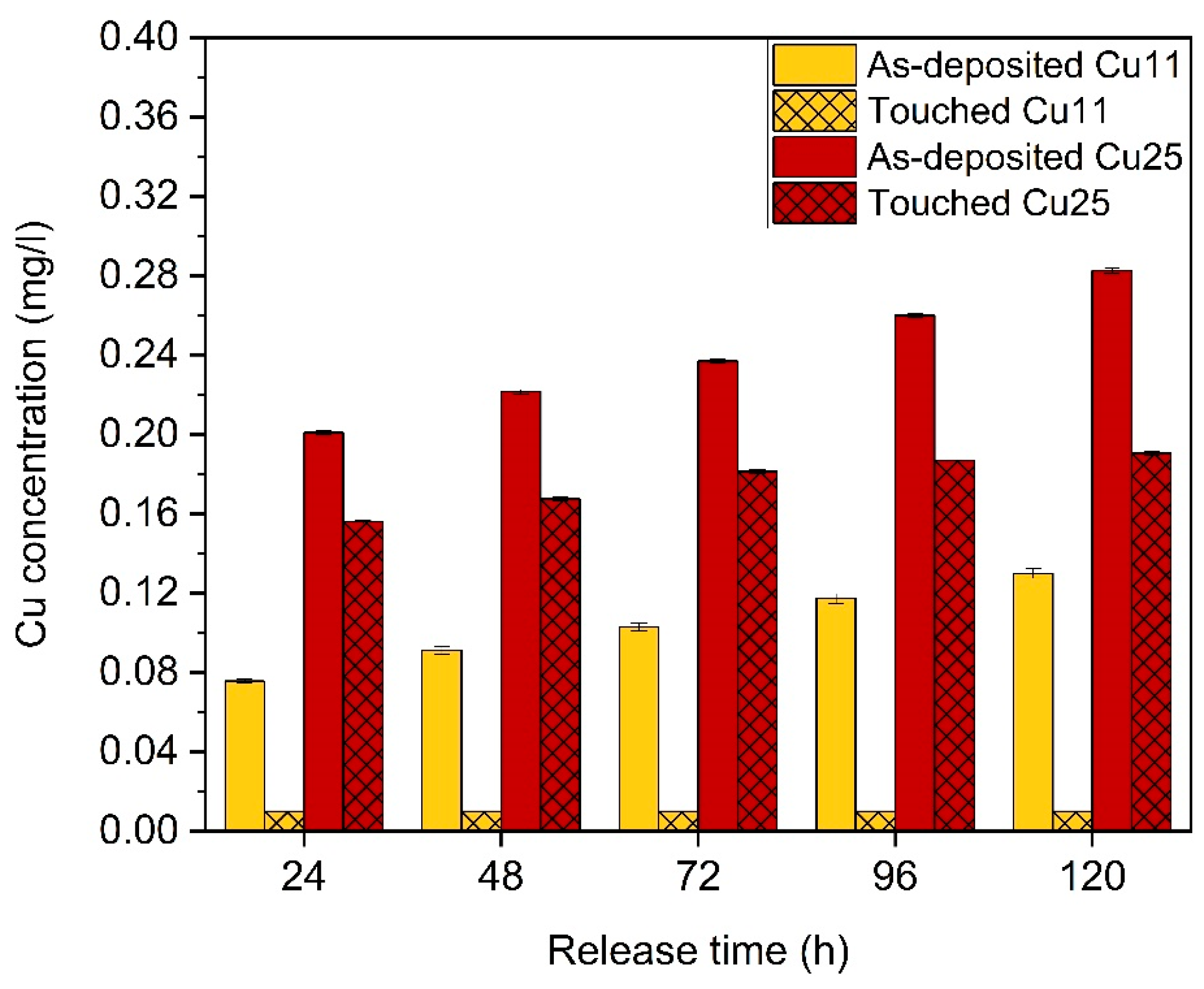
| Temperature (°C) | Bias Voltage (V) | N2 Pressure (Pa) | Arc Current (A) | Time (min) | |
|---|---|---|---|---|---|
| Adhesion layer (ZrN) | 400 | −50 | 1.5 | 150 | 10 |
| ZrN-Cu coating | 400 | −50 | 1.5 | 150 | 100 |
| Sample | Cu (at.%) | Zr (at.%) | N (at.%) | H (GPa) | E (GPa) |
|---|---|---|---|---|---|
| Cu11 | 11 | 45.7 | 43.3 | 24.2 ± 0.7 | 299 ± 8 |
| Cu25 | 25.1 | 37.9 | 37 | 17.8 ± 0.3 | 242 ± 7 |
| Sample | As-Deposited | Untouched | Touched | |||
|---|---|---|---|---|---|---|
| Cu11 | Cu25 | Cu11 | Cu25 | Cu11 | Cu25 | |
| Sa (nm) | 59 ± 8 | 84 ± 5 | 60 ± 5 | 90 ± 8 | 55 ± 13 | 84 ± 7 |
Disclaimer/Publisher’s Note: The statements, opinions and data contained in all publications are solely those of the individual author(s) and contributor(s) and not of MDPI and/or the editor(s). MDPI and/or the editor(s) disclaim responsibility for any injury to people or property resulting from any ideas, methods, instructions or products referred to in the content. |
© 2024 by the authors. Licensee MDPI, Basel, Switzerland. This article is an open access article distributed under the terms and conditions of the Creative Commons Attribution (CC BY) license (https://creativecommons.org/licenses/by/4.0/).
Share and Cite
Behrangi, S.; Staňková, E.; Sedláček, I.; Šimoníková, L.; Souček, P.; Buršíková, V.; Sochora, V.; Novotný, K.; Vašina, P. A Long-Term Study on the Bactericidal Effect of ZrN-Cu Nanostructured Coatings Deposited by an Industrial Physical Vapor Deposition System. Nanomaterials 2024, 14, 496. https://doi.org/10.3390/nano14060496
Behrangi S, Staňková E, Sedláček I, Šimoníková L, Souček P, Buršíková V, Sochora V, Novotný K, Vašina P. A Long-Term Study on the Bactericidal Effect of ZrN-Cu Nanostructured Coatings Deposited by an Industrial Physical Vapor Deposition System. Nanomaterials. 2024; 14(6):496. https://doi.org/10.3390/nano14060496
Chicago/Turabian StyleBehrangi, Sahand, Eva Staňková, Ivo Sedláček, Lucie Šimoníková, Pavel Souček, Vilma Buršíková, Vjačeslav Sochora, Karel Novotný, and Petr Vašina. 2024. "A Long-Term Study on the Bactericidal Effect of ZrN-Cu Nanostructured Coatings Deposited by an Industrial Physical Vapor Deposition System" Nanomaterials 14, no. 6: 496. https://doi.org/10.3390/nano14060496
APA StyleBehrangi, S., Staňková, E., Sedláček, I., Šimoníková, L., Souček, P., Buršíková, V., Sochora, V., Novotný, K., & Vašina, P. (2024). A Long-Term Study on the Bactericidal Effect of ZrN-Cu Nanostructured Coatings Deposited by an Industrial Physical Vapor Deposition System. Nanomaterials, 14(6), 496. https://doi.org/10.3390/nano14060496





